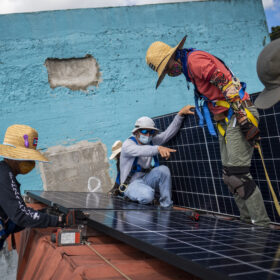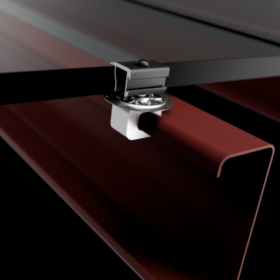If you attended Intersolar North America 2020, you likely spent a good bit of time checking out one of the show’s main attractions, the Solar Games, a three round competition where teams were tasked with building a solar-plus-storage system on a mock residential roof and were judged based on speed, quality and overall project execution.
The competition was such a hit that, not only is it coming back in 2021, but Intersolar hosted a webinar to go over how the industry’s first installer competition began, what it was like to compete on the roofs and where the competition is headed in 2021 and beyond. The webinar featured 2020 champion Sol-Up’s Joseph Folken, technical advisor Johan Alfsen, judge Rudy Saporite, and lead coordinator Emily Nelson.
The competition
According to Saporite, all the contestants were expert installers working in a controlled environment — they didn’t have to worry about dealing with the elements, the roof was essentially at ground level and all of the mounts were installed prior to the start of the competition. Because of the ease provided by those factors, Saporite shared that the judges had to find a way to be detail-oriented without nitpicking. He also shared that the only struggles he saw among the contestants came from adjusting to the components that they were provided.
According to Saporite, one of the main focuses for the 2021 iteration of the solar games will be to expand the scoring system, in order to allow for more separation between competitors.
From an installer’s perspective, Folken said that his biggest adjustment came from the pressure of installing in front of judges and the crowd. It wasn’t his first time installing in front of a crowd, sharing that neighbors of customers have been known to bring chars and congregate around installations before, but never to the same degree as the bleachers at the Solar Games.
After the initial nerves, Folken shares that he and his team were able to re-focus and concentrate on the installation, eventually setting into the groove that helped them win the competition. When asked if Sol-Up would be competing again in 2021, Folken said that they are and that they’re looking to defend their title.
More to come
Alongside developing more expansive scoring parameters, Nelson shared that one of the main focuses of the 2021 competition will be getting more teams involved and expanding the scope of the competition. The organizers are also planning a greater prize for the winning team, as well as greater supplemental prizes for some of the runner-ups.
Potentially the most interesting development came when Nelson was asked if Diversified Communications had considered adding a ground-mount competition in upcoming years. She said that there’s been significant outside interest and that it’s something that the organizers have been interested in for a while. It would be a significant logistical issue, yet it’s not outside of the realm of possibility in the future.
This content is protected by copyright and may not be reused. If you want to cooperate with us and would like to reuse some of our content, please contact: editors@pv-magazine.com.









I concur, there ground-mounts should be included. An example from years ago, https://img1.wsimg.com/isteam/ip/2fdce722-8fc7-46de-91c9-1556b434958f/Screenshot_2015-05-09-13-24-22%20(0).png/:/
In addition, I think there should be dogs barking when the solar athletes are working. 🙂 There could also be checks for ergonomics as well. For example, reduceinjuries.com/energy
What do you think?
Nice, at ground level. Unless you are a Hobbitt in the Shire, your house is NOT at ground level. When Tesla did my home with the Tesla Solar Glass Roof, every single solar tile and glass tile and trim, was hand carried up an extention ladder. Hours of leg tiring, back breaking lifting that could have been made better if they had a mechanical fork lift that could work off of a slanted driveway. You would think the people who design futuristic cars and trucks could come up with a variable tilt fork lift for roof materials delivery. Maybe Space X could land the materieals on the roof for less than they paid to get the materials up to the workers by hours of up and down the ladder first before they could even start the job. Definatly a great job when they were through…all hand installed and hand carried but they left a lot of profit on the table with this one.
When my neighbor had their roof replaced the roofer used a ladder with a hoist/lift on it.
Basically, this https://www.youtube.com/watch?v=XVtFgurVgzQ
You would think the labor saving would pay for itself quickly.